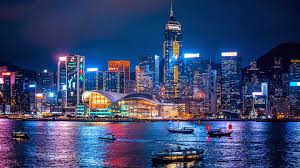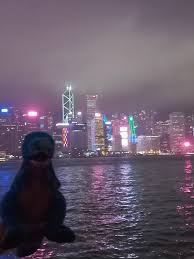“The Hong Kong in My Heart | A Prose Poem of Hong Kong”

Lin Siyi
Guangdong: To a child growing up in Guangdong, “Hong Kong” is a story told through the experiences of the previous generation.
When I was still naïve, my grandfather would often visit relatives in Hong Kong. Before ever setting foot there, I had a vague imagination of the bustling city described in stories—travelers crossing oceans and navigating busy urban streets.
Later, in my modern Chinese literature classes, the works of writers like Xiao Hong, Eileen Chang, and Xi Xi infused this impression with more tangible emotions. At that time, Hong Kong seemed fluid, a place that accommodated people from all directions.
As one era faded into another, and I arrived in the present, I found many classmates from Hong Kong at school. After becoming friends, our conversations revealed the vitality and courage of the younger generation of Hong Kongers. These chance encounters at different stages pieced together a fragmented silhouette of Hong Kong in my heart.

It wasn’t until I graduated last year, when my teacher tasked me with researching books, that I finally visited Hong Kong in person. Although most of the literature I had read about Hong Kong was in the form of novels, the Hong Kong in my heart felt like a prose poem.
A prose poem, like Hong Kong, blurs boundaries—it is a seamless blend of diverse spaces.
Old tong laus (tenement buildings) coexist with skyscrapers on the same street. From the closed shops of Sham Shui Po to the neon-lit Central, the MTR connects it all.
Victoria Harbour has no gates, its waters shimmering in the night. Neon lights become the stars of the city, and in the sea breeze, bands at the harbor sing timeless Cantonese songs. In those moments, one forgets the relentless march of time, wishing only to linger in the present.
The rhythm of a prose poem lacks strict metrical constraints, much like the dynamic crowds on Hong Kong’s streets. The fast-paced, high-efficiency lifestyle has long been Hong Kong’s hallmark, creating an awe-inspiring sense of elitism.
Yet, when I actually set foot in this city, I found myself lost at Kennedy Town MTR station, swept forward by the continuous flow of people. Everyone seemed to be rushing to an important meeting, unwilling to be late. The very units of time seemed to contract in the hurried footsteps of passersby.
At the same time, I sat quietly in the University of Hong Kong’s library, flipping through A Catalogue of Rare Books in the Fung Ping Shan Library. Around me, others examined ancient texts with magnifying glasses and film cameras.
When I finished a book and stepped out of the reading hall, the sunset had already sunk into the clouds. The standardized ticks of the clock were but a preset framework; it was our collective experiences that truly composed the essence of time.
As I dined at HKU’s cafeteria, the view before me was of the sea framed by two high-rises. The city and the ocean, as a combined landscape, carried the infinite musings of those gazing out the windows.
In literary history, Hong Kong has embraced travelers from all directions. These visitors, in turn, penned stories of their lives in the city. I can never forget Eileen Chang lighting agarwood incense in a family heirloom censer to tell stories of pre-war Hong Kong, Xiao Hong searching for warmth and love as her spiritual home at the end of time, or Xi Xi writing of the building she lived in as “beautiful” instead of correcting the typo in “Murray.” Literature provides a deep guide to Hong Kong, sparking my curiosity about its past and present.
So, during another summer, I visited Hong Kong again, stepping into the Hong Kong Literature Hall.
Hong Kong is mountainous, so climbing slopes and stairs is part of daily life. The typhoon season brings sudden showers, making a comfortable, sturdy pair of shoes essential.
On a rainy day, I walked a kilometer to No. 7 Mulberry Street. Though it connects bustling main roads, the street itself was quiet. The small exhibition hall upstairs showcased the paths taken by Hong Kong writers and the traces they left behind. The more I learned, the heavier it felt—history, like waves crashing on the rocky shores of Hong Kong Island, repeatedly struck the hearts of visitors.
I sat in the reading room, reading the curator’s message: “Although the dust has settled on the Hong Kong Literature Hall, we still have to traverse the roaring seas of time, with the surging ocean on the left and the rising mountains on the right.” A copy of The Field of Life and Death was neatly placed on the shelf, telling a story that, like a prose poem, offers solace to those who pause.
Beyond visual impressions, Hong Kong’s many long-established brands left me with classic culinary memories. Signs for Hong Kong-style tea restaurants and Cantonese dim sum are ubiquitous.
In different seasons, flavors represent a certain attitude. Shrimp dumplings must have twelve folds, and the split on a char siu bun must be just right. This meticulous craftsmanship and steadfast seriousness transform history into rain tapping on windows. Behind the kitchen doors, chefs simmer lotus seed paste until it is soft and mellow, free of bitterness.
This lightness of flavor balances the heavy reality, supporting countless seemingly ordinary but deeply flavorful moments. In the helplessness of gain and loss, memories rekindle through tradition, leading to infinite possibilities.
Behind every classic legacy lies its own story and quiet resolve, granting people enough weight to stand firm in time.
“One cup, two pieces—it tastes wonderful.” The moment I bit into the translucent wrapper of a shrimp dumpling, the rich, savory flavor filled my heart, reminding me of the last time I shared dim sum with old friends. The satisfaction of taste brings instant peace and focus. In the lingering aroma of food, history’s vast past is air-dried by the years, leaving only the shared flavors of the present. Tomorrow’s scenery feels promising.
Even after leaving Hong Kong, I often recall the band at Victoria Harbour, the cable cars of Lantau Island, and the history of the Literature Hall. Like lighthouses floating on the sea, these images illuminate the mountains and waters for every observer.
Each of these images, leaping between historical and modern contexts, forms a prose poem, articulating the intentions of every visitor engaging with the text of Hong Kong.





